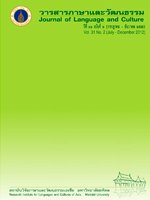The occurrence of repairs in Burmese telephone conversations between Thai call center operators and Burmese customers
Main Article Content
Abstract
This research aims to analyze the types, frequency and devices of repair that occurred in Burmese telephone conversations between Thai call center operators and Burmese customers. The data consist of 80 conversations recorded from a call center. The study is based on the framework of Schegloff, Jefferson and Sacks (1977).
The research reveals that there were three types of repairs, which included 1) self-initiated and self-repair, 2) other-initiated and self-repair, and 3) other-initiated and other-repair. The most frequently used types were other-initiated and self-repair, and self-initiated and self-repair, respectively. On the other hand, it found that Burmese customers started repair initiation more frequently than Thai call center operators. The results of other-initiated repair devices show that there were six devices: 1) A short word (...) ʃíɴ ‘Yes?, I beg your pardon, what did you say?’, 2) The questions: (...) bà lέ ‘What?’, bέ lò lέ ‘How?’, 3) Repetition as a part of the trouble–source turn plus a question: noun shò dà bà lέ ‘What does ‘…’ mean?’, 4) Repetition as part of the trouble-source with rising intonation, 5) “You Mean” plus a possible understanding of prior turn: statement plus (...) dì lò lá ‘Is it like this’, and 6) Request: (...) pjɔ́ pé bà nɔ̀ ‘Please tell me’. In addition, combined devices were also found in this study.
Article Details
The articles featured in the Journal of Language and Culture (JLC) constitute academic works representing the viewpoints of the respective author(s). It is crucial to note that these opinions do not necessarily reflect those of the Editorial Board.
All articles published in JLC are released under the Creative Commons Attribution 4.0 International License (CC BY 4.0). This license grants permission for unrestricted use, distribution, and reproduction in any medium, provided proper credit is given to the original author(s) and the source.


